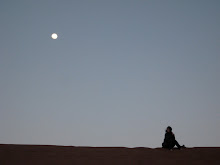
Hoghe has an untraditional body for a performer, and as the show begins he gives the audience time to get to know this body and get used to him in shared space. He walks slowly, along with Linyekula, across the stage, covering most of the area before any more real action happens. This isn’t the first dance piece to ever start slowly and methodically, but the particular kind of slowness experienced here is distinct. It’s not boring, though I’m sure more than one mind wandered a bit. But this kind of individual mental wandering seems built into the experience, or at least doesn’t seem to be in direct opposition to it. Hoghe lines the perimeter of the stage with pieces of white printer paper and it is a beautiful ritual; it is pure visual pleasure caught up with the difficulty his body has bending over to drop the paper down and Linyekula’s less repetitive actions that happen simultaneously inside the in-progress frame.
After introducing us to his small body and prominently curved spine through his humble parade around the space, Hoghe’s participation stays peripheral for much of the first half of the show. He stands with his back to the audience and then lays face up for a while in the back-center of the space. Linyekula approaches a pile of small, smooth rocks at the front of the stage and, at first, lines them up from the front to the back of the stage in an action that recalls Hoghe’s white paper placements. He moves, bending at the waist and dropping his head’s weight toward the ground, swaying with control and grace, yet charged with animal-like momentum. He rises onto his toes, but his legs curve as if he has no knees. Once he removes his shirt, we can see this body as a specimen of ideal anatomy; we see every muscle and bone. When he moves to the front of the stage after gathering the stones, we can see his breath and the subtle and not-so-subtle flexing of his spine even more clearly.
The two performers are meant to represent different cultures, but more basically than that, they are there as individuals in their quite obviously different physical forms. The politics of cultural representation come from Hoghe’s European perspective, and though I was not personally offended by the depiction of an African body within the aestheticized European frame, the point of view is less racially sensitive than we’re used to in progressive dance in this country. It takes a certain amount of belief in the intentions of the artist here, and an acceptance of his use of difference to create new beauty from forms that are both archetypal and original. It’s tricky, with works like these we’re always left thinking about whose image is not seen: a woman with a deformity, for example, or the truly emancipated black male form. Total inclusiveness, however, is not a requirement for art to hold great meaning, to be truly good, or to be beautiful.
The essence of each performer’s movement becomes representative of them; there is little in the way of virtuosic dance, though it is more than obvious that Linyekula is capable of technical perfection in many forms. His body is shown to be incredible, and a strong contrast to Hoghe, but not “better,” necessarily. At one point, Hoghe takes off his shirt, lies down on his belly, and Linyekula places stones along his curved spine. Small, unexplainable movements that follow this—sliding the rocks along the floor away from him, for example—contain all the emotion of the most dramatic acting or danced movement. Every small action is charged. You wait for it a long time, past the point of interest even, and then still feel it quite deeply. Linyekula places his arm around Hoghe and Hoghe returns the gesture; they walk slowly to the front of the stage and then simply look at the audience. They have done little, but contained a lot in a relatively short period of time: moments of transcendence, the occasional drop in momentum, nakedness, imperfection, and one man’s sensitive vision of a softer, more tender humanity.
Original article online HERE

No comments:
Post a Comment